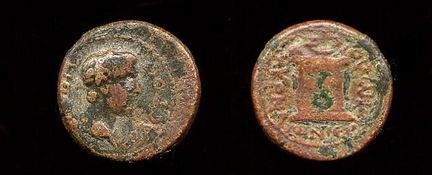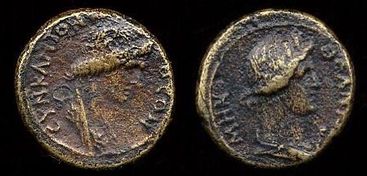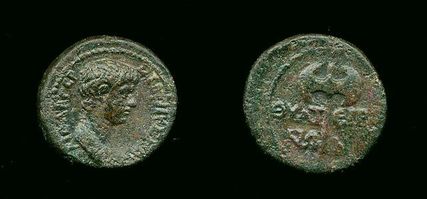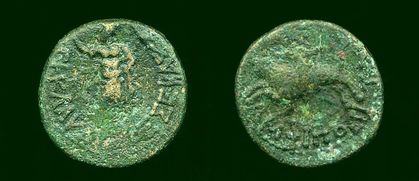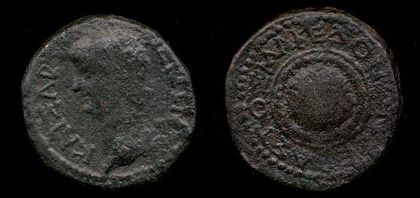Coin of Tiberius. Asia: Ionia, Smyrna, bronze, 18 mm. This small coin of Tiberius was minted late in that emperor’s life, circa 29-35 A.D., hence it would still have been in use when Paul passed through Smyrna. It features the laureate head of the emperor and on its reverse, a garlanded altar. Furthermore it is signed by the proconsul Petronius. It is well nigh certain that he stopped here at least for a few days in order to visit with the faithful who had been establishing a strong church in Smyna.
During the time that Paul was in Ephesus we are not told if he ever traveled to the nearby cities where evangelisations were taking place under the direction of his surrogates. Nevertheless, Paul may have seen coins like this one from Smyrna brought in to Ephesus by travelers and exchanged there for Ephesian coins; afterall Paul was engaged in a business, in commerce, and Smyrna was only about 33 miles, as the crow flies, from Ephesus.
The next city on his itinerary was the former capital of Asia itself, Pergamum. This was another venerable city like Ephesus, and it had also produced an abundance of coins from earlier Hellenic times. In fact a sizeable percentage of the silver cistophori mentioned above were minted in Pergamum. They are too expensive for my collection. I have been fortunate in acquiring an affordable example of Pergamum’s bronze coins.
Coin of Quasi-Autonomous issue. Asia: Pergamum, brass, 17-18 mm. This coin features two busts on each side. The obverse has a personified depiction of the Roman Senate, whilst the reverse has a personified depiction of the goddess Roma. These coins were minted in Asia, probably at Pergamum, sometime in the years of 40-60 A.D. and could have been seen and handled by Paul on this trip from Ephesus to Troas.
Coin of Nero. Asia: Lydia, Thyatira, bronze, 18 mm. This is the first coin we have of Nero; it was minted about 50-54 A.D. (before he was emperor) and features Nero’s youthful and draped bust, and on its reverse, a double ax with the word Thyatira in Greek: QUATEIRHNWN (N.B. The fonts used on this website's software do not support Greek letters). This major city is close to Pergamum, and is also one of the group of cities, including Sardis, Smyrna and Ephesus, et al., which were eventually spoken of as the ‘Seven Churches of Asia’. Thyatira was also the home town of Lydia, the God-fearing woman whom Paul met previously in Philippi. Paul could have seen this coin during his stay-over in Pergamum, or he may have diverted his route to go to Thyatira for some brief evangelizing. He would have been interested to see this new coin issue depicting the new Roman emperor.
After Pergamum the road goes directly to the port city of Adramyttium, and then follows along the coastline making a circuit to the port of Troas. Here the previous journey is repeated: the taking of a ship bound for the port of Neapolis in Macedonia and then making the short overland walk to Philippi, the site of his previous imprisonment, but also of the Christian community that had grown up there since his first visit.
55-56 A.D. Macedonia, Greece and Illyricum
“He left for Macedonia. When he had gone through those regions and had given the believers much encouragement, he came to Greece, where he stayed three months…He decided to return through Macedonia…”. Acts 20:1b,2, 3
We are not given any particulars as to what Paul saw and did in Philippi other than the probability that it was here Paul met Titus, just returned from Corinth. The news that Titus brought concerning the church there was very, very good, as Paul exults in II Corinthians 7:5-15. This report must have eased Paul in his mind and provided him with the time he had hoped for to complete his goals in Macedonia without having to hurry to Corinth.
The next town on the Via Egnatia was Amphipolis. On the previous trip Paul had not tarried long enough there to have seen any coins, but on this trip he had the time to stay longer in each town. If he was not visiting with the believers, he would have been seeking to create new ones (there was still a real missionary extant in Paul’s breast!). In Amphipolis he would have seen a coin of Claudius minted there. It is also possible, even probable, that some of these base metal coins made their ways back and forth between these proximate Macedonian cities (Amphipolis is only 30 miles, as the crow flies from Philippi, and maybe half again that distance by road).
Coin of Claudius. Macedonia: Amphipolis, leaded bronze, 23 mm. This is an interesting coin. The obverse does not feature the usual portrait of the emperor. Instead this coin has the figure of Claudius standing in military dress, raising his hand and holding in the other a staff. The reverse features Artemis Tauropolis riding on her iconic bull and the city’s name in Greek: AMFIPOLITWN [written in Greek alphabet, not supported by this site's software]
The next city along the Via Egnatia was the mighty Thessalonika. As we have already seen, there was a large, active mint there, producing copper coins, and Paul would have seen the new ones of the new emperor, Nero. We are blessed in having an abundant supply of them available to us in the ancient coins trade, and I was able to acquire three different issues. Two are shown below.
Coin of Nero. Macedonia: Thessalonika, copper, 24 mm. We do not have a precise dating for his coin but know that it was minted early in Nero’s reign and was used, like those of Claudius before, for the whole koinon; these always had as their reverse device the iconic Macedonian shield.
(Page 8)
